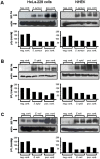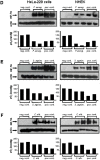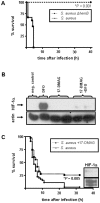Activation of hypoxia inducible factor 1 is a general phenomenon in infections with human pathogens
- PMID: 20644645
- PMCID: PMC2904385
- DOI: 10.1371/journal.pone.0011576
Activation of hypoxia inducible factor 1 is a general phenomenon in infections with human pathogens
Abstract
Background: Hypoxia inducible factor (HIF)-1 is the key transcriptional factor involved in the adaptation process of cells and organisms to hypoxia. Recent findings suggest that HIF-1 plays also a crucial role in inflammatory and infectious diseases.
Methodology/principal findings: Using patient skin biopsies, cell culture and murine infection models, HIF-1 activation was determined by immunohistochemistry, immunoblotting and reporter gene assays and was linked to cellular oxygen consumption. The course of a S. aureus peritonitis was determined upon pharmacological HIF-1 inhibition. Activation of HIF-1 was detectable (i) in all ex vivo in biopsies of patients suffering from skin infections, (ii) in vitro using cell culture infection models and (iii) in vivo using murine intravenous and peritoneal S. aureus infection models. HIF-1 activation by human pathogens was induced by oxygen-dependent mechanisms. Small colony variants (SCVs) of S. aureus known to cause chronic infections did not result in cellular hypoxia nor in HIF-1 activation. Pharmaceutical inhibition of HIF-1 activation resulted in increased survival rates of mice suffering from a S. aureus peritonitis.
Conclusions/significance: Activation of HIF-1 is a general phenomenon in infections with human pathogenic bacteria, viruses, fungi and protozoa. HIF-1-regulated pathways might be an attractive target to modulate the course of life-threatening infections.
Conflict of interest statement
Figures









Similar articles
-
The human HIF (hypoxia-inducible factor)-3alpha gene is a HIF-1 target gene and may modulate hypoxic gene induction.Biochem J. 2009 Oct 23;424(1):143-51. doi: 10.1042/BJ20090120. Biochem J. 2009. PMID: 19694616
-
Oxygen-independent stabilization of hypoxia inducible factor (HIF)-1 during RSV infection.PLoS One. 2008 Oct 7;3(10):e3352. doi: 10.1371/journal.pone.0003352. PLoS One. 2008. PMID: 18839041 Free PMC article.
-
Activity of heme oxygenase-1 affects expression levels of hypoxia inducible factor-1 gene in vitro.Chin Med J (Engl). 2012 Apr;125(7):1310-5. Chin Med J (Engl). 2012. PMID: 22613607
-
The Regulatory Mechanism of Hypoxia-inducible Factor 1 and its Clinical Significance.Curr Mol Pharmacol. 2024;17:e18761429266116. doi: 10.2174/0118761429266116231123160809. Curr Mol Pharmacol. 2024. PMID: 38389420 Review.
-
Contribution of hypoxia inducible factor-1 during viral infections.Virulence. 2020 Dec;11(1):1482-1500. doi: 10.1080/21505594.2020.1836904. Virulence. 2020. PMID: 33135539 Free PMC article. Review.
Cited by
-
Oxygen sensing by protozoans: how they catch their breath.Curr Opin Microbiol. 2015 Aug;26:41-7. doi: 10.1016/j.mib.2015.04.006. Epub 2015 May 17. Curr Opin Microbiol. 2015. PMID: 25988702 Free PMC article. Review.
-
Induced Pluripotent Stem Cell-Derived Brain Endothelial Cells as a Cellular Model to Study Neisseria meningitidis Infection.Front Microbiol. 2019 May 29;10:1181. doi: 10.3389/fmicb.2019.01181. eCollection 2019. Front Microbiol. 2019. PMID: 31191497 Free PMC article.
-
Hypoxia-inducible factor-1α-dependent protection from intestinal ischemia/reperfusion injury involves ecto-5'-nucleotidase (CD73) and the A2B adenosine receptor.J Immunol. 2011 Apr 1;186(7):4367-74. doi: 10.4049/jimmunol.0903617. Epub 2011 Feb 28. J Immunol. 2011. Retraction in: J Immunol. 2017 Sep 1;199(5):1942. doi: 10.4049/jimmunol.1700997. PMID: 21357264 Free PMC article. Retracted.
-
Regulation of immunity and inflammation by hypoxia in immunological niches.Nat Rev Immunol. 2017 Dec;17(12):774-785. doi: 10.1038/nri.2017.103. Epub 2017 Oct 3. Nat Rev Immunol. 2017. PMID: 28972206 Free PMC article. Review.
-
The chemorepellent, SLIT2, bolsters innate immunity against Staphylococcus aureus.Elife. 2023 Sep 29;12:e87392. doi: 10.7554/eLife.87392. Elife. 2023. PMID: 37773612 Free PMC article.
References
-
- Shimoda LA, Manalo DJ, Sham JS, Semenza GL, Sylvester JT. Partial HIF-1alpha deficiency impairs pulmonary arterial myocyte electrophysiological responses to hypoxia. Am J Physiol Lung Cell Mol Physiol. 2001;281:202–208. - PubMed
-
- Pugh CW, Ratcliffe PJ. Regulation of angiogenesis by hypoxia: role of the HIF system. Nat Med. 2003;9:677–684. - PubMed
-
- Ivan M, Kondo K, Yang H, Kim W, Valiando J, et al. HIFalpha targeted for VHL-mediated destruction by proline hydroxylation: implications for O2 sensing. Science. 2001;292:464–468. - PubMed
-
- Mazure NM, Brahimi-Horn MC, Berta MA, Benizri E, Bilton RL, et al. HIF-1: master and commander of the hypoxic world. A pharmacological approach to its regulation by siRNAs. Biochem Pharmacol. 2004;68:971–980. - PubMed
Publication types
MeSH terms
Substances
LinkOut - more resources
Full Text Sources
Molecular Biology Databases

